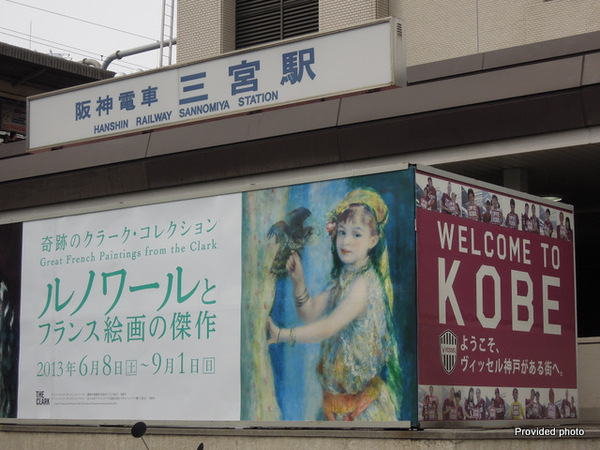
Beloved Works of Art Coming Home to the Clark
(1).jpg) |
|
.jpg) |
Clark Art Institute Director Michael Conforti speaks at the opening of the Clark's traveling exhibit in Tokyo in February 2013. Below, Pierre-Auguste Renoir's 'A Box at the Theater (At the Concert)' is one of the Clark's pieces that is coming home to Williamstown for the July 4 re-opening of the museum. |
WILLIAMSTOWN, Mass. — You thought you had to do a lot of packing and unpacking for a trip.
The Sterling and Clark Art Institute this spring welcomed back 73 works from its collection of 19th century French paintings. The artwork had been taken on a world tour to 10 different cities over the past three years while the Clark's 1955 "white building" underwent renovations.
The paintings will enjoy a homecoming of sorts when the Clark reopens to the public on July 4, debuting a major expansion and improved gallery space in the white building.
Recently, Clark Director Michael Conforti and senior curator Richard Rand talked about the massive undertaking that enabled the Clark to put Williamstown on the world stage.
"Believe me, when we talked about this world tour of the greatest pictures from our collection, foremost in our mind, certainly was, if nothing else, we're going to make sure the pictures are well cared for and properly displayed," Rand said.
"We worked only with institutions that have great standards that we could accept and partners we knew and partners we got to know.
"That was foremost in our minds."
The tour began in Milan, Italy, in March 2011 and ended in Houston, Texas, last month. In between, the Clark's paintings were seen in France, Spain, London, Montreal, Japan and China.
In all, the art traveled 31,629 miles, or nearly 7,000 miles more than the circumference of the Earth at the equator.
The Clark reports that about 2 million people saw its works on tour, and the hope is that some of them will be enticed to see the rest. Part of the Clark's strategy in launching the tour was to promote the museum and the Berkshires at each stop along the way.
Each stop was a major undertaking.
"You simply can't imagine the level of oversight that our registrarial and curatorial staff go through as we move things from place to place," Conforti said.
At least four people from the Clark accompanied the art on each journey along the way. The artwork was double-crated each time it was shipped and inspected before and after crating to note any possible issues.
"We didn't really have much trouble with the paintings," Rand said. "There was one painting we decided after several stops we weren't happy with what was going on on the surface, so we took it out of the show.
"That was something we decided to do early on if anything happened we weren't happy with."
The art was divided up into four different groups for transport between cities, in order to ensure that if there was a problem with a flight not all of the items from the collection would be at risk, Rand and Conforti said.
All in all, the tour went off without a hitch, the pair said.
Rand praised the Clark's partner institutions for the care they took in displaying and protecting the paintings, which looked a little different on the walls of, say, the Shanghai Museum than they will next month on South Street.
"All of the pictures were put behind glass," Rand said. "The frames were reinforced. They were encased in a way that we would never show them at the Clark because at the Clark, we want to take the glass off. We want people to be able to see things up close. But on a world tour, we made sure that everything was protected from the crowds that were coming.
"In fact, I'll tell you one thing: It gave us pause and made us realize why these issues are important. At many of the venues, as we were packing things up afterward, we found fingerprints on the glass.
"They like to touch."
Tags: Clark Art, exhibit, museum, reopening,

 WILLIAMSTOWN, Mass. — The Prudential Committee on Wednesday signed off on more than $1 million in cost cutting measures for the planned Main Street fire station.
WILLIAMSTOWN, Mass. — The Prudential Committee on Wednesday signed off on more than $1 million in cost cutting measures for the planned Main Street fire station.













